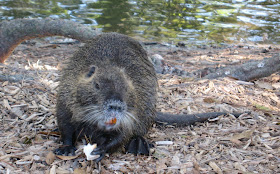Last Friday, we had our monthly Nature Day. It was a beautiful day in the mid-70's. We had a small group, but a lot of fun and interesting discoveries!

I've posted about our local nutria before, but we enjoyed feeding them on this beautiful day. Note the orange teeth, bare tail, fingers, and webbed hind feet.
 This is what greeted us - lots of nutria, ducks and geese! I've never seen the nutria being so "friendly" before.
This is what greeted us - lots of nutria, ducks and geese! I've never seen the nutria being so "friendly" before. There were 5 baby nutria! They were so cute! I guess he's kind of hard to see in this small photo, but he's near the bottom of the picture a little to the right.
There were 5 baby nutria! They were so cute! I guess he's kind of hard to see in this small photo, but he's near the bottom of the picture a little to the right.
Here's a sign they've posted about nutria in the park. It says:
The nutria is a large rodent that lives near water. It is native to South America, but was introduced into many parts of Europe and North America to be raised for their fur. Nutrias have brown fur with a somewhat white tipped muzzle, orange teeth, small ears, webbed hind feet, and a long, hairy tail. They areabout 14" long from the nose to the start of the tail. The tail is 12" to 17" long. Nutria can weigh up to 20 lbs. and live along the banks of lakes, marshes, ponds, and rivers and are very good swimmers. They are herbivores with large appetites and usually have a negative impact on other species because they often over harvest edible plants. A male will live in a den with two or three females and their offspring.

I saw some vultures sitting in a tree by the water. As we got closer to where they'd been, we saw this nutria (I believe) skeleton! (The skull is on the lower right) I know some of you might think this is disgusting - sorry! I just thought it was neat that it was picked "clean" but that the fur was lying around it. Vultures play such an important role in cleaning up the environment.
 Isn't this beautiful??? It's a hornworm and will become a Sphinx moth. It was BIG!
Isn't this beautiful??? It's a hornworm and will become a Sphinx moth. It was BIG! Lots of palmettos (something I couldn't identify before!)
Lots of palmettos (something I couldn't identify before!) Turkey Tail Fungus
Turkey Tail Fungus
Very camouflaged stink bug! I wouldn't have seen him, but I saw him land and "ran" over to the tree to take some photos.
So, that was our nature day. What have you been doing outdoors this fall?
What great nature photos. That horn worm is just awesome looking! You sure got a good shot there!
ReplyDeleteThat worm is fabulous and the fungus is very cool! Great photos.
ReplyDelete